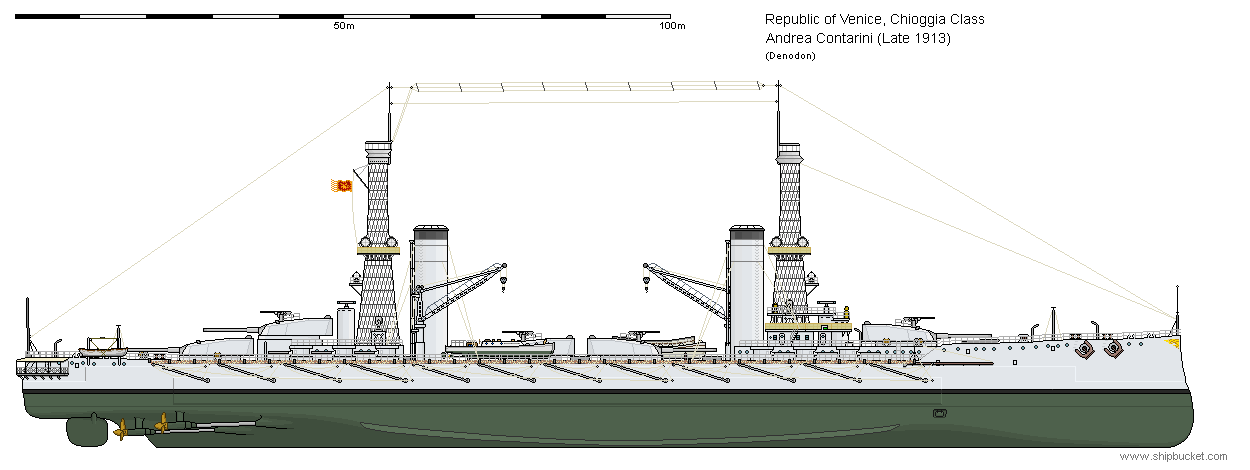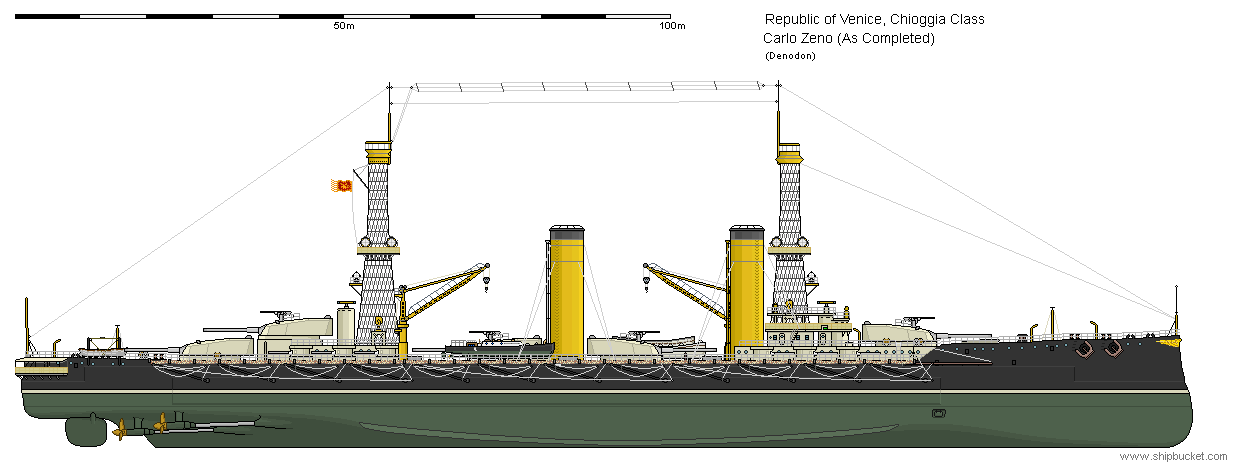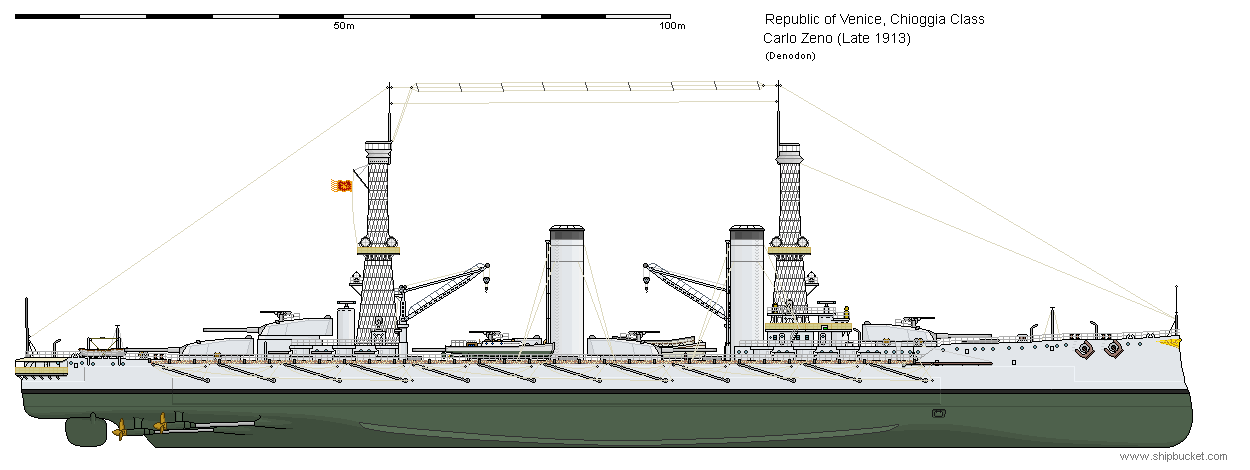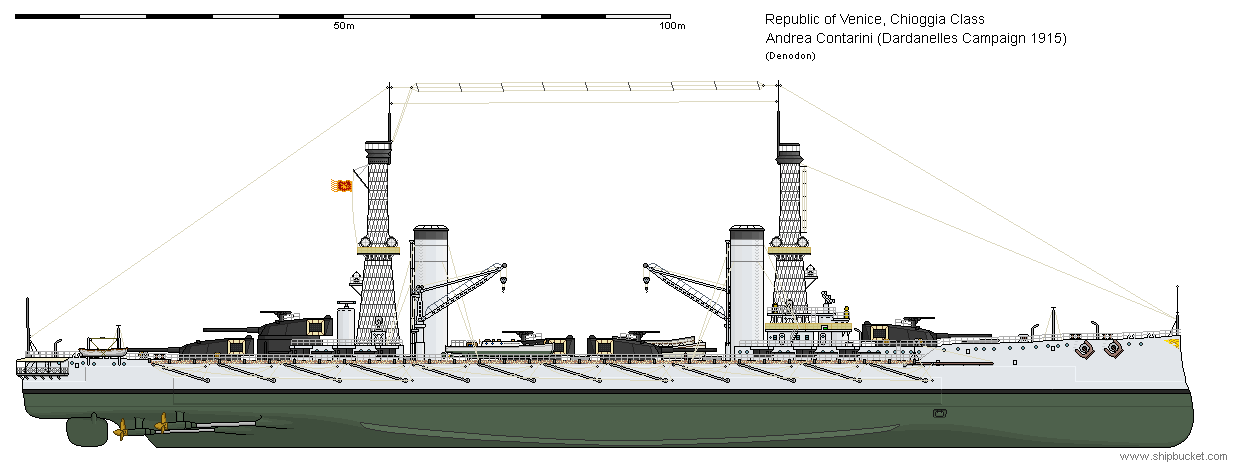Background
So here we have the Chioggia Class, named after the Battle of Chioggia in 1380 between the Republic of Venice and the Republic of Genoa. The outcome of the battle was a Venetian victory which saw the Geonese vessels never again venture into the Adriatic sea.
The two ships I opted to draw differ in machinery and boiler room layouts which would make them more half-sisters than true sisterships.
The first ship is named Andrea Contarini, after the Doge of Venice at the time who became a hero for his direct actions in the war and battle along with his contributions of a significant amount of his own funds to support the war effort.
The second ship is named Carlo Zeno after the Venetian Admiral whos arrival late in the conflict turned the tides into the favour of the Venetians, making him another hero of the republic.
With the commissioning of the HMS Invincible in 1909, the Royal Navy ushered in a new form of capital ship to almost rival the earlier HMS Dreadnought. Whilst the later revolutionised Battleship design, the former, classified as a Battlecruiser, revolutionsed the design of the armoured cruiser. Just as in Dreadnought, this brought with it a new arms race between the major powers of Britain and Germany to build ever faster, more powerful battlecruisers.
Whilst Venice was not the major naval power in the Mediterranean that it had once been, commerce by sea and protecting the crucial trade links was still considered vital and something which the new class of capital ships would be ideally suited. A ship with the firepower to rival a battleship with comparable protection but a speed advantage was considered highly advantageous in dictating the terms of battle in favour of the republic.
Multiple designs were iterated and trialed with heavy involvement from the British. The ultimate design chosen for construction adopted a near identical main battery arrangement of the new German battlecruisers of the Moltke class but with the more powerful British 12″ gun. The decision to have one of the aft turrets to be superfiring made these the first ships in the Venetian fleet to carry a superfiring main battery. A reasonably heavy battery of 6″ guns in casemates along the ships sides provided considerable deterrent against torpedo boat attacks, for which additional 4″ quick-firing guns were installed atop of the main battery turret roofs to supplement fire.
Unusually for the designs of Europe, Venice adopted a Lattice or Cage mast for the new ships, in keeping with the first generation of Battleships designed just a few years before. These were intended to reduce weight considerably compared to the tripods favoured by the British whilst providing a stable platform for spotting that was less vulnerable to incoming fire. Only the Tsar of Russias fleet had any ships with similar structures in Europe, along with ships bought by Greece as surplus from the American fleet.
The Ships

The Andrea Contarini was laid down late in 1909 and commissioned just in time for the Coronation of King George V of the United Kingdom where the new ship resplendent in an eye-pleasing Victorian scheme was presented alongside numerous other foreign vessels as part of celebrations.

As tensions continued to rise leading towards 1914, the ship would lose her vibrant colours to be replaced by the new, soon to be standard pale grey overall scheme intended to make the ships harder to spot in the bright sunshine and haze of the Mediterranean.

Carlo Zeno, completed early in 1912 and also painted in the same scheme initially as her sister marked a slight revision in thinking with the overall design of the class. Whilst the earlier ship had boiler rooms placed at either ends of her machinery spaces, truncated as they were by the wing positioned main barbettes, the Carlo Zeno had a more conventional layout with all boiler rooms positioned ahead of her machinery spaces. This necessitated a slight repositioning of the aft barbette to ensure clear arcs of fire around the repositioned aft funnel. Otherwise she was identical to her sister and carried identical amounts of armament and armour.

Unfortunately for Venice, the Mark XI 12″/50s used in the new ships proved to be not quite up to the original expectations. These guns, also used by the British adopted a longer barrel and a heavier charge in order to increase the muzzle velocity of the shell, thus improving range and striking power. In actual service however it was found the guns were inconsistent, suffering from rather considerable issues with dispersion at the same elevation which complicated gunlaying. This was later found to be the result of the larger charge not burning completely by the time the shell left the barrel. This also resulted in a shorter life for each barrel in service. Little could be done however despite efforts to resolve these issues and would plague the ships for the rest of their service careers.
World War I
The outbreak of World War I saw Venice join its ally the United Kingdom in declaring war on Imperial Germany and the Austro-Hungarian Empire. The two ships were involved in the chase of German shipping including the Battlecruiser Goeben which escaped to the then-neutral Ottomans.
Both sisters again participated in the ill-fated Gallipoli campaign in an attempt to push the Dardanelles strait after the Ottomans sided with the Central Powers. Andrea Contarini hit in a mine which saw her heavily flooded but miraculously remained afloat. She returned to Venice via Greece where she spent the rest of the war receiving repairs.

The Carlo Zeno fared better than her sister, taking only light damage from shore artillery before withdrawing with the rest of the allied fleets. For a time she supported the Otranto Barrage, an effort at bottlenecking the Austro-Hungarian fleet to the Adriatic, before deploying once more to Greece where she provided escort to allied shipping efforts. In 1917 she narrowly avoided a torpedo attack from an unknown but presumed to be German Submarine (one of her escorts was not so lucky).
Otherwise the remainder of the war was rather uneventful. She briefly supported intervention in the Black Sea following the loss of the Russian fleet to revolution but saw no more notable action.
Postwar
The two ships by 1919 were starting to show their age. Their turbines by now were in dire need of overhaul. Their guns had been outclassed by the other Mediterranean powers and their speed eclipsed. Their mixed coal and oil firing was also considered obsolete by this point with the near total replacement of coaling with oil fired ships having begun even before the outbreak of war.
Regardless, the two vessels remained in commission until 1920 where both were laid up just beyond the Venetian lagoon. Following the signing of the Washington Naval Treaty, both old ships were listed for disposal. The still damaged Andrea Contarini was turned into a target ship and finally sunk in 1924, whilst the Carlo Zeno was sold for scrap, with the breaking having been completed by 1923, thus ending the careers of Venices’ first battlecruisers.
Springsharp Report
Andrea Contarini, Most Serene Republic of Venice Battlecruiser laid down 1909 (Engine 1910)
Displacement:
20,320 t light; 21,388 t standard; 22,490 t normal; 23,371 t full load
Dimensions: Length (overall / waterline) x beam x draught (normal/deep)
(590.50 ft / 584.00 ft) x 96.00 ft x (27.00 / 27.81 ft)
(179.98 m / 178.00 m) x 29.26 m x (8.23 / 8.48 m)
Armament:
6 – 12.00″ / 305 mm 50.0 cal guns – 914.65lbs / 414.88kg shells, 100 per gun
Breech loading guns in turret on barbette mounts, 1909 Model
3 x Twin mounts on centreline ends, majority aft
1 raised mount aft – superfiring
4 – 12.00″ / 305 mm 50.0 cal guns – 914.65lbs / 414.88kg shells, 100 per gun
Breech loading guns in turret on barbette mounts, 1909 Model
1 x Twin mount on sides, forward deck aft
1 x Twin mount on sides, aft deck forward
12 – 6.00″ / 152 mm 45.0 cal guns – 108.93lbs / 49.41kg shells, 120 per gun
Breech loading guns in casemate mounts, 1909 Model
12 x Single mounts on sides, evenly spread
8 – 4.00″ / 102 mm 50.0 cal guns – 33.89lbs / 15.37kg shells, 150 per gun
Breech loading guns in deck mounts, 1909 Model
8 x Single mounts on centreline, evenly spread
8 raised mounts
Weight of broadside 10,725 lbs / 4,865 kg
Main Torpedoes
2 – 18.0″ / 457 mm, 12.20 ft / 3.72 m torpedoes – 0.606 t each, 1.212 t total
submerged side tubes
Armour:
- Belts: Width (max) Length (avg) Height (avg)
Main: 11.0″ / 279 mm 384.00 ft / 117.04 m 13.50 ft / 4.11 m
Ends: 4.00″ / 102 mm 200.00 ft / 60.96 m 12.50 ft / 3.81 m
Upper: 4.00″ / 102 mm 495.00 ft / 150.88 m 7.50 ft / 2.29 m
Main Belt covers 101 % of normal length - Torpedo Bulkhead – Additional damage containing bulkheads:
1.50″ / 38 mm 495.00 ft / 150.88 m 8.50 ft / 2.59 m
Beam between torpedo bulkheads 82.00 ft / 24.99 m - Gun armour: Face (max) Other gunhouse (avg) Barbette/hoist (max)
Main: 10.0″ / 254 mm 7.00″ / 178 mm 10.0″ / 254 mm
2nd: 10.0″ / 254 mm 7.00″ / 178 mm 10.0″ / 254 mm
3rd: 6.00″ / 152 mm 1.50″ / 38 mm – - Armoured deck – multiple decks:
For and Aft decks: 2.00″ / 51 mm
Forecastle: 1.00″ / 25 mm Quarter deck: 1.00″ / 25 mm - Conning towers: Forward 10.00″ / 254 mm, Aft 8.00″ / 203 mm
Machinery:
Coal and oil fired boilers, steam turbines,
Direct drive, 4 shafts, 64,974 shp / 48,471 Kw = 25.92 kts
Range 4,300nm at 12.00 kts
Bunker at max displacement = 1,984 tons (50% coal)
Complement:
917 – 1,193
Cost:
£2.130 million / $8.520 million
Distribution of weights at normal displacement:
Armament: 2,051 tons, 9.1 %
– Guns: 2,049 tons, 9.1 %
– Weapons: 2 tons, 0.0 %
Armour: 7,098 tons, 31.6 %
– Belts: 3,449 tons, 15.3 %
– Torpedo bulkhead: 234 tons, 1.0 %
– Armament: 1,815 tons, 8.1 %
– Armour Deck: 1,291 tons, 5.7 %
– Conning Towers: 309 tons, 1.4 %
Machinery: 2,813 tons, 12.5 %
Hull, fittings & equipment: 8,313 tons, 37.0 %
Fuel, ammunition & stores: 2,170 tons, 9.6 %
Miscellaneous weights: 45 tons, 0.2 %
– Hull below water: 10 tons
– Hull above water: 15 tons
– On freeboard deck: 10 tons
– Above deck: 10 tons
Overall survivability and seakeeping ability:
Survivability (Non-critical penetrating hits needed to sink ship):
27,347 lbs / 12,404 Kg = 31.7 x 12.0 ” / 305 mm shells or 9.2 torpedoes
Stability (Unstable if below 1.00): 1.24
Metacentric height 6.9 ft / 2.1 m
Roll period: 15.3 seconds
Steadiness – As gun platform (Average = 50 %): 56 %
– Recoil effect (Restricted arc if above 1.00): 0.39
Seaboat quality (Average = 1.00): 1.05
Hull form characteristics:
Hull has raised forecastle,
a ram bow and a cruiser stern
Block coefficient (normal/deep): 0.520 / 0.525
Length to Beam Ratio: 6.08 : 1
‘Natural speed’ for length: 24.17 kts
Power going to wave formation at top speed: 53 %
Trim (Max stability = 0, Max steadiness = 100): 53
Bow angle (Positive = bow angles forward): -5.00 degrees
Stern overhang: 0.00 ft / 0.00 m
Freeboard (% = length of deck as a percentage of waterline length):
Fore end, Aft end
– Forecastle: 21.00 %, 29.00 ft / 8.84 m, 23.50 ft / 7.16 m
– Forward deck: 30.50 %, 16.50 ft / 5.03 m, 16.50 ft / 5.03 m
– Aft deck: 35.00 %, 16.50 ft / 5.03 m, 16.50 ft / 5.03 m
– Quarter deck: 13.50 %, 16.50 ft / 5.03 m, 18.00 ft / 5.49 m
– Average freeboard: 18.53 ft / 5.65 m
Ship space, strength and comments:
Space – Hull below water (magazines/engines, low = better): 96.2 %
– Above water (accommodation/working, high = better): 130.4 %
Waterplane Area: 38,047 Square feet or 3,535 Square metres
Displacement factor (Displacement / loading): 100 %
Structure weight / hull surface area: 177 lbs/sq ft or 864 Kg/sq metre
Hull strength (Relative):
– Cross-sectional: 0.95
– Longitudinal: 1.58
– Overall: 1.00
Adequate machinery, storage, compartmentation space
Excellent accommodation and workspace room